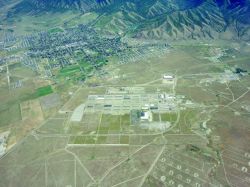s Congress mulls giving its nod to the 2005 round of BRAC (Base Realignment & Closing), which targets 33 major U.S. military bases for closure and 29 others for realignment, many communities affected by previous BRAC rounds are doing quite well in their redevelopment efforts.
BRAC communities have created more than 100,000 jobs so far, replacing about 90 percent of the civilian jobs lost as a result of previous BRAC rounds in 1988, 1991, 1993 and 1995, according to the Dept. of Defense’s Office of Economic Adjustment.
One success story can be found about 35 miles (56 km.) southwest of Salt Lake City, where the growing southwestern construction market is spawning a small roofing materials manufacturing cluster at a former facility that refurbished military vehicles. Utah Industrial Depot (UID) is the current name for a 1,700-acre (688-hectare) chunk of land jettisoned from the Tooele Army Depot during the 1993 BRAC. The 23,500-acre (9,510-hectare) Tooele Army Depot, a munitions storage facility, remains UID’s largest neighbor.
Carlisle SynTech and its Hunter Panels subsidiary, both part of North Carolina-based Carlisle Companies, are the newest industrial tenants at UID, having built adjacent factories this year on a 50-acre (20-hectare) site.
Carlisle SynTech manufactures single-ply roofing products and systems and is opening a facility to manufacture its Sure-Weld TPO membranes and accessories. The 250,000-sq.-ft. (23,225-sq.-m.) facility is the company’s fourth roofing membrane plant in the U.S.
Tom Timmerman, Carlisle SynTech’s vice president, manufacturing operations, says the company chose the Salt Lake area for logistics reasons as it provides a good base for distribution to western states customers. He says UID won out over three other Salt Lake area sites.

|
|
The Utah Industrial Depot covers some 1,400 acres (567 hectares) near Tooele, west of Salt Lake City. UID is now seeing significant investment in the construction materials sector. |
“The site was very close to being ready to build,” Timmerman says. “Most of the desired infrastructure was in place or close by. The Army Depot and UID offered good rail access which is critical to our operations. UID controlled the property and this made the sale more straightforward, allowing us to meet our tight schedule. UID, the State of Utah and Tooele City put together a very favorable incentive package, including incentives for the Hunter facility, referred to as Phase 2, should we build it within 18 months, which we have done. The incentive package and the ?can do’ attitudes of both the local officials and the UID were the final selling points for the Tooele site.
“Logistics was the primary reason for the Salt Lake City area, but very close behind was the quality of the labor market,” he says. “I met with plant managers and other business people in every community we considered, including locations in Nevada and Arizona, and Carlisle was most impressed with the labor market in the Salt Lake City area. To date we have not been disappointed.”
Hunter Panels, headquartered in Portland, Maine, is building its fifth U.S. manufacturing facility adjacent to the Carlisle SynTech plant. Hunter Panels manufactures rigid polyiso roof insulation for use in public and commercial and residential buildings. The new 230,000-sq.-ft. (21,300-sq.-m.) factory will serve Southwestern and West Coast states with operations slated to begin in the first quarter of 2006.
“These are energy-conscious states where the building community recognized the value of thermal efficiency in roofing design,” said Alma Garnett, Hunter’s vice president. Rapidly expanding Hunter also recently announced its fifth U.S. facility, to be built in Smithtown, Pa.
Formerly home to the Tooele Army Depot’s truck refurbishing facility, UID still fills that bill for commercial operations such as DaimlerChrysler‘s Freightliner division, which is expanding its used truck refurbishing facility at UID from 134,000 sq. ft. (12,450 sq. m.) to 196,000 sq. ft. (18,200 sq. m.) and boosting employment from 150 to 220. The facility’s primary job is reconfiguring long-haul trucks to make day trucks by removing sleepers and shortening their wheel bases.
The two new factories give Utah Industrial Depot some welcome momentum following a post-9-11 period that saw the Depot endure an economic drought as the Army tightened security around its former holding. Not many industrial parks have to deal with an Army machine gun nest guarding the front gate as UID did for three years. That was just one of several security measures the Army took subsequent to the terrorist attacks.
“It drove interest to about zero and set us back three full years,” says Mark Smith, UID’s marketing manager. “But things are improving on a regular basis.”
Smith hopes to build on UID’s budding construction supply cluster with the recruitment of a supplier to the huge KraftMaid cabinetry plant now under construction 16 miles (26 km.) to the east in West Jordan. If the company comes to Tooele, it will add to UID’s current employment of 1,000.